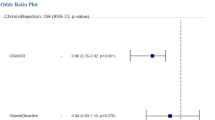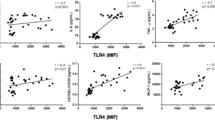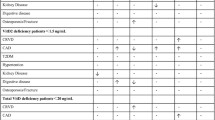Abstract
Purpose
In this study, we aimed to investigate the effect of paricalcitol and calcitriol usage on vitamin D receptor (VDR) contents of CD8+ , CD4+ lymphocytes and monocytes in stage 5d chronic kidney disease (CKD) patients.
Methods
Thirty-six hemodialysis patients older than 18 years of age and 19 healthy controls (group HC) without any known acute or chronic diseases were included in the study. The group of patients undergoing scheduled hemodialysis comprised three subgroups: group CL: patients on calcitriol (n: 10), group PC: patients on paricalcitol (n: 13), and group NT: patients not taking any vitamin D or VDR activating medications (n: 13). CD8+/VDR, CD4+/VDR and MONO/VDR values were representing the ratio of VDR representing cells among related cell group. On the other hand, values of CD8+/MFI, CD4+/MFI and MONO/MFI have shown the total amount of cellular VDR content per cell which has been given as of mean fluorescence intensity in the flow cytometric process. Main CKD mineral bone disorder parameters such as a hemogram, serum BUN, creatinine, albumin, Ca, iP, iPTH, 25(OH)D3 levels were also measured.
Results
Average VDR contents in CD8+, CD4+ and monocytes were not different among three patient groups on hemodialysis. But in all hemodialysis subgroups, CD8+/VDR, CD4+/VDR, MONO/VDR, CD8+/MFI, CD4+/MFI and MONO/MFI levels were found to be higher compared with the healthy control subjects (p < 0.001). Among hemodialysis groups, no significant CD8+/VDR, CD4+/VDR, and MONO/VDR content differences were found with regard to the type of VDR activator agent used. There was no difference in serum levels of 25(OH)D3 and CRP among groups participating in the study.
Conclusion
There was no difference between CD8+/VDR, CD4+/VDR, and MONO/VDR levels in hemodialysis patients using calcitriol or paricalcitol, suggesting that both treatment agents may have a similar effect on VDR contents in lymphocytes and monocytes in that patient population. But in all hemodialysis subgroups, CD8+/VDR, CD4+/VDR, and MONO/VDR levels were found to be higher compared with the healthy control subjects, suggesting an overexpression of VDR through a non CRP and/or 25(OH)D3 dependent mechanism.
Similar content being viewed by others
References
Bolton CH, Downs LG, Victory JG, Dwight JF, Tomson CR, Mackness MI et al (2001) Endothelial dysfunction in chronic renal failure: roles of lipoprotein oxidation and pro-inflammatory cytokines. Nephrol Dial Transplant 16(6):1189–1197
Sarnak MJ, Levey AS (2000) Cardiovascular disease and chronic renal disease: a new paradigm. Am J Kidney Dis 35(4 Suppl 1):117–131
Stenvinkel P (2002) Inflammation in end-stage renal failure: could it be treated? Nephrol Dial Transplant 17(Suppl 8):33–38
Akchurin OM, Kaskel F (2015) Update on inflammation in chronic kidney disease. Blood Purif 39(1–3):84–92
Holick MF, Chen TC (1080S) Vitamin D deficiency: a worldwide problem with health consequences. Am J Clin Nutr 87(4):1080S–S1086
van Etten E, Mathieu C (2005) Immunoregulation by 1, 25-dihydroxyvitamin D3: basic concepts. J Steroid Biochem Mol Biol 97(1–2):93–101
Maalouf NM (2008) The non-calciotropic actions of vitamin D: recent clinical developments. Curr Opin Nephrol Hypertens 17(4):408–415
Hochberg ZE (2003) Vitamin D and rickets. Karger Medical and Scientific Publishers, Basel (e-ISBN: 978-3-318-00975-0)
Liu C, Li H (2019) Correlation of the severity of chronic kidney disease with serum inflammation, osteoporosis and vitamin D deficiency. Exp Ther Med 17(1):368–372
Lopez-Munoz P, Beltran B, Saez-Gonzalez E, Alba A, Nos P, Iborra M (2019) Influence of vitamin D deficiency on inflammatory markers and clinical disease activity in IBD patients. Nutrients. 11:5
Lucas RM, Gorman S, Geldenhuys S, Hart PH (2014) Vitamin D and immunity. F1000Prime Rep 6:118
Özkan B, Döneray H (2011) D vitamininin iskelet sistemi dişi etkileri. Cocuk Sagligi Hastaliklari Dergisi 54(2):99–119
Haussler MR, Whitfield GK, Haussler CA, Hsieh JC, Thompson PD, Selznick SH et al (1998) The nuclear vitamin D receptor: biological and molecular regulatory properties revealed. J Bone Miner Res 13(3):325–349
Zhang Y, Leung DY, Richers BN, Liu Y, Remigio LK, Riches DW et al (2012) Vitamin D inhibits monocyte/macrophage proinflammatory cytokine production by targeting MAPK phosphatase-1. J Immunol. 188(5):2127–2135
Baeke F, Takiishi T, Korf H, Gysemans C, Mathieu C (2010) Vitamin D: modulator of the immune system. Curr Opin Pharmacol 10(4):482–496
Li YC, Kong J, Wei M, Chen ZF, Liu SQ, Cao LP (2002) 1, 25-Dihydroxyvitamin D 3 is a negative endocrine regulator of the renin-angiotensin system. J Clin Invest 110(2):229–238
Vaziri ND (2004) Roles of oxidative stress and antioxidant therapy in chronic kidney disease and hypertension. Curr Opin Nephrol Hypertens 13(1):93–99
Welsh J (2012) Cellular and molecular effects of vitamin D on carcinogenesis. Arch Biochem Biophys 523(1):107–114
Sugden JA, Davies JI, Witham MD, Morris AD, Struthers AD (2008) Vitamin D improves endothelial function in patients with Type 2 diabetes mellitus and low vitamin D levels. Diabet Med 25(3):320–325
Sanz AB, Izquierdo MC, Sanchez-Nino MD, Ucero AC, Egido J, Ruiz-Ortega M et al (2014) TWEAK and the progression of renal disease: clinical translation. Nephrol Dial Transplant 29(Suppl 1):i54–i62
Gupta J, Mitra N, Kanetsky PA, Devaney J, Wing MR, Reilly M et al (2012) Association between albuminuria, kidney function, and inflammatory biomarker profile in CKD in CRIC. Clin J Am Soc Nephrol 7(12):1938–1946
Almeida ACSF, Siqueira MC, Bonan NB, Dambiski A, Bertuzzo G, Moreno-Amaral AN et al (2019) Vitamin D levels reverberate in monocytes modulation in hemodialysis patients. J Cell Physiol. 2019:25. https://doi.org/10.1002/jcp.28290
Ateş I, Ozkayar N, Yılmaz FM, Bayrakçı N, Neselioğlu S, Erel O et al (2018) Oxidative stress level in patients with chronic kidney disease. Ortadogu Med J 10(1):45–50
Levin A, Bakris GL, Molitch M, Smulders M, Tian J, Williams LA et al (2007) Prevalence of abnormal serum vitamin D, PTH, calcium, and phosphorus in patients with chronic kidney disease: results of the study to evaluate early kidney disease. Kidney Int 71(1):31–38
Graeff-Armas LA, Kaufmann M, Lyden E, Jones G (2018) Serum 24, 25-dihydroxyvitamin D3 response to native vitamin D2 and D3 Supplementation in patients with chronic kidney disease on hemodialysis. Clin Nutr 37(3):1041–1045
Ogunkolade BW, Boucher BJ, Prahl JM, Bustin SA, Burrin JM, Noonan K et al (2002) Vitamin D receptor (VDR) mRNA and VDR protein levels in relation to vitamin D status, insulin secretory capacity, and VDR genotype in Bangladeshi Asians. Diabetes 51(7):2294–2300
Peacock M (2010) Calcium metabolism in health and disease. Clin J Am Soc Nephrol 5(Suppl 1):23–30
Çidem M, Karacan İ, Beytemur O, Kara S (2017) Prevalence and risk factors for vitamin D deficiency in patients with widespread musculoskeletal pain. Turk J Med Sci. 47(3):728–731
Funding
No financial disclosure was declared by the authors.
Author information
Authors and Affiliations
Corresponding author
Ethics declarations
Conflict of interest
No conflict of interest was declared by the authors.
Additional information
Publisher's Note
Springer Nature remains neutral with regard to jurisdictional claims in published maps and institutional affiliations.
Rights and permissions
About this article
Cite this article
Sözel, H., Köksoy, S., Ozdem, S. et al. Lymphocyte and monocyte vitamin D receptor expression during paricalcitol or calcitriol treatments in patients with stage 5 chronic kidney disease. Int Urol Nephrol 52, 1563–1570 (2020). https://doi.org/10.1007/s11255-020-02475-1
Received:
Accepted:
Published:
Issue Date:
DOI: https://doi.org/10.1007/s11255-020-02475-1




